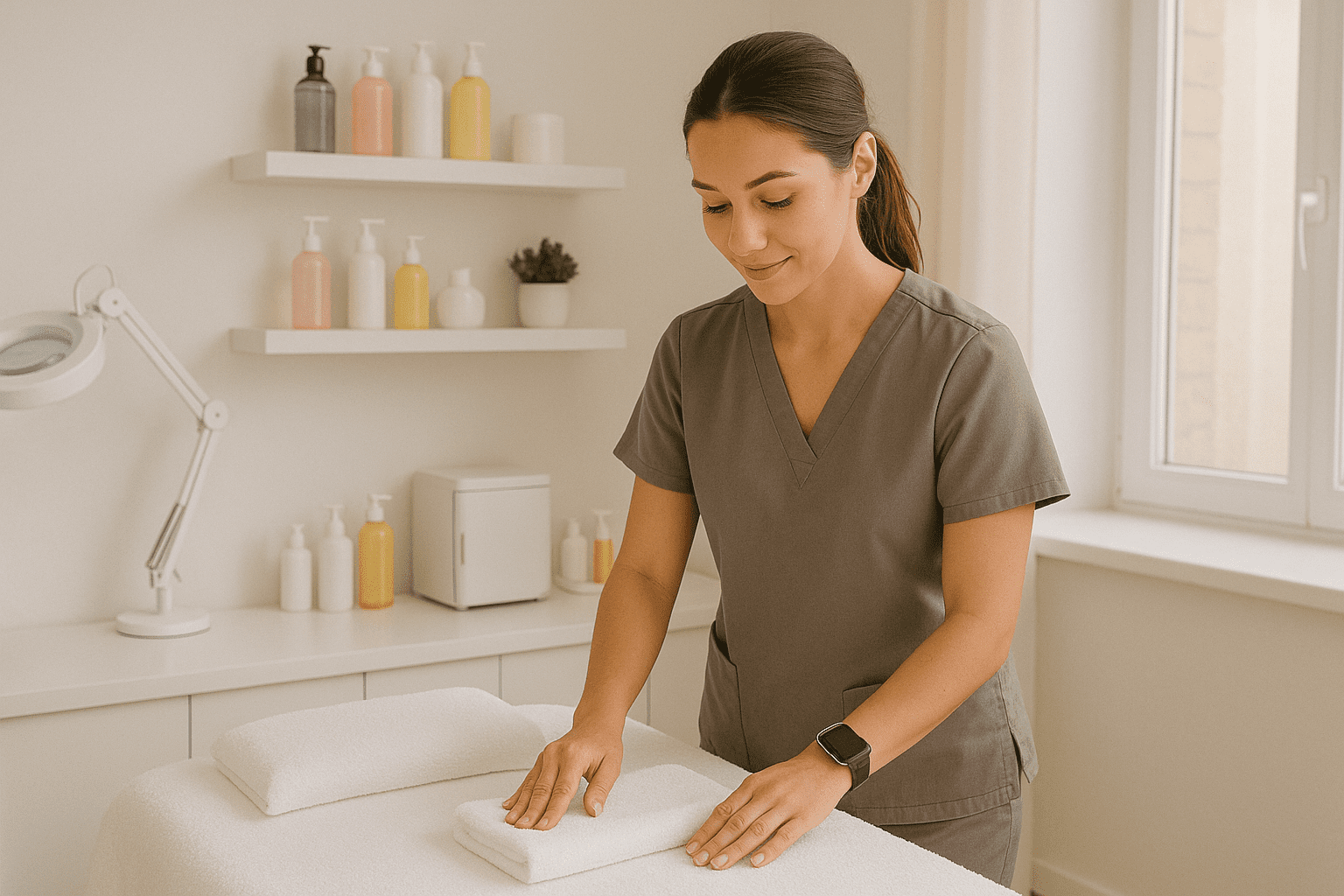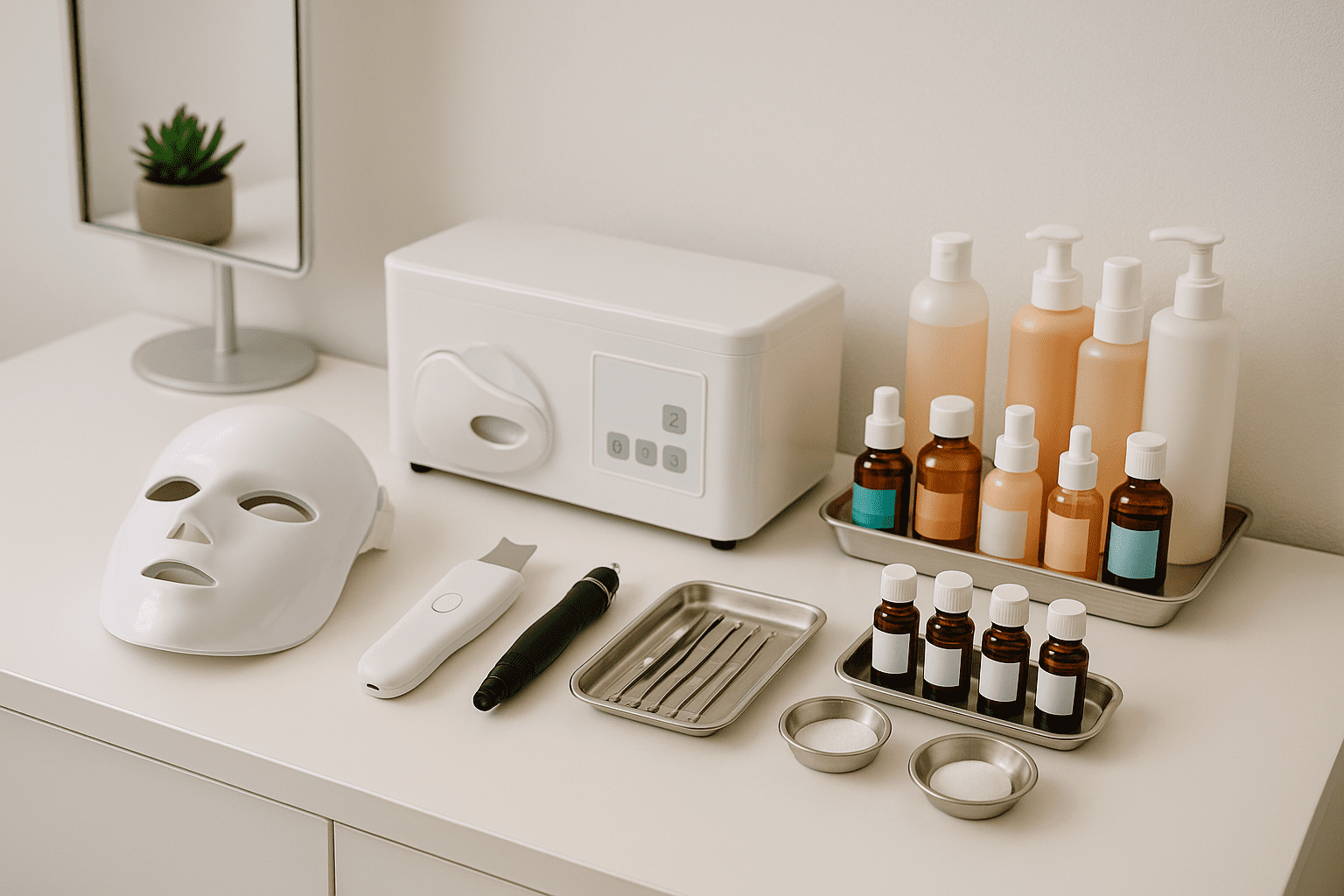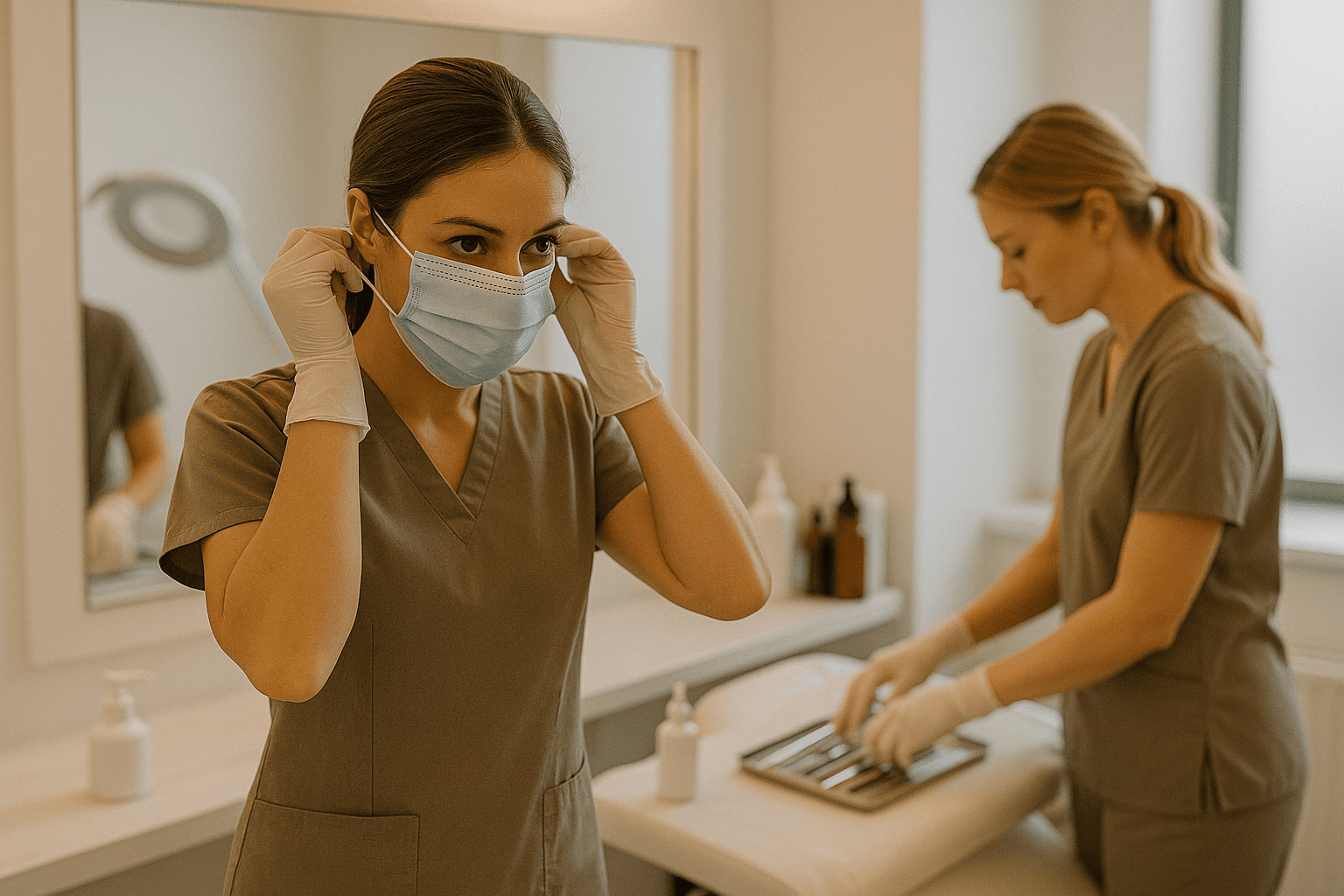Aesthetics Beauty Clinic Business Launch: 10 Step Guide to Starting a Successful Aesthetics Beauty Clinic
Table of Contents
Introduction
Now is definitely a good time to look at starting a aesthetics beauty clinic. UK aesthetics industry is thriving. With rising demand for non-surgical treatments like Botox, dermal fillers, and skin rejuvenation, aesthetic beauty clinics are becoming a popular business choice for healthcare professionals and entrepreneurs alike. But while the market presents huge potential, launching a clinic isn’t as simple as renting a room and ordering supplies.
If your services include prescription-only treatments, you’re entering a regulated healthcare space. This means you’ll need to register with the Care Quality Commission (CQC) and meet strict standards around safety, staffing, record keeping and governance. Even for non-regulated services, client expectations, insurance requirements and reputational risks mean your set-up must be professional from day one.
This guide is for anyone planning to open a CQC-regulated aesthetics beauty clinic in England. We’ll cover everything from treatment types and premises to registration, staffing and marketing. Whether you’re a nurse prescriber branching out, or a business owner partnering with clinical staff, you’ll find clear, actionable steps to launch with confidence.
By the end of this 10-step guide, you’ll understand:
- What aesthetic treatments require CQC registration
- How to structure and register your business legally
- What equipment, staffing and policies are needed to comply with CQC regulations
- How to attract the right clients while staying compliant
Let’s break down the journey to launching a safe, successful and fully compliant aesthetics beauty clinic in the UK.

Step 1: Decide Your Service Range – Regulated vs Non-Regulated Treatments
Before registering or investing in your clinic, it’s essential to define your treatment menu — and understand whether it includes regulated healthcare activities.
Across the UK, aesthetic treatments that involve medical oversight, prescription drugs, or clinical decision-making may require registration with a health and social care regulator. These include:
- Care Quality Commission (CQC) – England
- Care Inspectorate Wales (CIW) – Wales
- Care Inspectorate – Scotland
- Regulation and Quality Improvement Authority (RQIA) – Northern Ireland
Your choice of treatments directly impacts whether you must register, what staffing is required, and the compliance standards you must meet.
Regulated aesthetic treatments typically include:
- Botulinum toxin injections (Botox) – as these are prescription-only medications (POMs)
- Dermal fillers – when used for medical or therapeutic purposes
- Skin rejuvenation procedures using prescription anaesthetics or devices requiring clinical oversight
- Minor surgical procedures – e.g. mole removal or thread vein treatment
- Laser or intense pulsed light (IPL) therapies – when used beyond basic cosmetic use
Non-regulated beauty treatments include:
- Facials, waxing, tinting, massages, and make-up
- Microneedling – when performed without prescription substances
- LED therapy, superficial peels, and other non-invasive skincare
If your clinic combines both regulated and non-regulated services, you must:
- Keep clinical services separate in physical layout and process
- Ensure regulated procedures are led by qualified healthcare professionals
- Comply with the correct regulatory body based on your UK location
Being clear on this distinction ensures your registration application is accurate and prevents costly delays or refusals.
💡 Tip: Refer to your national regulator’s guidance on “regulated activities” in healthcare aesthetics to determine what applies to your clinic setup.
Step 2: Understand Registration Requirements for Aesthetic Clinics
If you intend to provide regulated aesthetic treatments, your clinic must be registered with the appropriate health and social care regulator for your UK nation. This is a legal requirement — operating without registration when it is required can lead to serious enforcement action, including prosecution, fines, or forced closure.
Regulators in the UK expect providers of healthcare-related aesthetic services to register before trading, especially where treatments involve:
- Prescription-only medicines (POMs), such as botulinum toxin
- Clinical judgement or diagnosis
- Invasive techniques or medical equipment
- Delivery by or under the supervision of a healthcare professional
If any of the above applies to your service model, registration is not optional.
You’ll need to demonstrate readiness across several key areas:
- A clearly defined Statement of Purpose setting out what services you offer
- A competent and qualified Registered Manager who meets fit person requirements
- Robust governance policies – including safeguarding, consent, infection control, and complaints handling
- Systems to support confidential record keeping and secure data handling
- Evidence that your staff are trained, supervised, and appropriately qualified
Registration timelines vary but can take between 10 to 14 weeks from application to approval, depending on your readiness and the complexity of your service.
Start preparing early. Many clinics use the registration window to finalise policies, complete staff recruitment, and begin light-touch marketing (as long as no regulated activities take place until approval).
Step 3: Create a Compliant Business Plan for Your Clinic
A strong, regulator-ready business plan is essential for launching an aesthetic clinic that offers regulated treatments. It is not just for banks or investors – it is also a key requirement when applying to health and social care regulators in the UK.
Unlike a standard beauty business plan, a compliant plan for a regulated aesthetics clinic must include:
- Regulated Service Summary – Outline what regulated treatments you will offer (e.g. botulinum toxin, fillers). – Specify who will deliver them – include qualifications and registration details.
- Statement of Purpose Alignment – Ensure your business plan aligns with the structure of your regulator’s required Statement of Purpose. – Include your clinic’s aims, intended outcomes, and who the service is for.
- Premises and Environment – Detail the layout of your treatment areas. – Show how clinical and non-clinical zones are separated. – Include infection control and emergency access details.
- Governance and Policies – Reference how your clinic will meet safeguarding, consent, complaints, and risk management requirements. – Summarise your approach to training, supervision and audits.
- Financial Plan – Show startup costs (equipment, insurance, staffing, premises). – Include projected income from both regulated and non-regulated services. – Add contingency planning for delays in registration or client uptake.
- Staffing Model – Include your Registered Manager (if required), their qualifications and DBS status. – Outline how you will maintain safe staffing levels and supervision.
If you are applying for CQC, CIW, RQIA or the Care Inspectorate, your plan should be auditable – meaning what you say you will do must be evidenced in practice.
Having a business plan that speaks to both investors and inspectors puts you in a strong position to launch safely and grow sustainably.

Step 4: Choose the Right Premises and Treatment Environment
Your premises are not just where you treat clients – they’re also a key part of your regulatory approval. Whether you lease a high street unit, convert a home clinic, or sublet within another business, your environment must meet strict healthcare-grade standards if offering regulated services.
Regulators expect to see:
- A clean, safe, and well-maintained environment
- Clear separation between clinical and non-clinical areas
- Secure storage for prescription medicines and equipment
- Handwashing facilities in treatment areas
- Fire safety, waste disposal and infection control compliance
If you’re offering both beauty and medical aesthetic treatments, you’ll need to design your layout carefully. For example, a consultation room may be used for both, but any clinical treatments must take place in a room that meets regulatory hygiene and privacy standards.
When choosing or designing your premises:
- Check planning use classification – most clinical services fall under D1/E(e) use
- Ensure access for clients with mobility needs, including step-free entry where possible
- Fit out treatment rooms with wipe-clean flooring, adequate lighting and emergency procedures displayed
- Have a separate, lockable space for storing sharps bins, clinical waste and medical supplies
- Make sure insurance, landlord permissions and local council requirements are all in place before trading
You will need to submit floor plans as part of your registration application. Inspectors may also visit your site before approval, especially if delivering services involving medicines, invasive procedures or regulated equipment.
Designing your clinic to meet both aesthetic expectations and regulatory compliance from the outset saves time and avoids costly refits later on.
Step 5: Register Your Clinic – Step-by-Step
Once your premises, staffing model and treatment list are confirmed, it’s time to apply for registration with the appropriate UK regulator. This process is critical – you cannot legally offer regulated aesthetic services until registration is approved.
While the exact process varies slightly between the Care Quality Commission (England), Care Inspectorate Wales, Care Inspectorate (Scotland) and RQIA (Northern Ireland), the core steps are similar:
- Set up your legal entity You must have a registered business (Ltd company, partnership or sole trader) with an official business address.
- Appoint a Registered Manager This is a legal requirement for most clinics. The manager must have relevant qualifications, experience, and pass a DBS (or PVG in Scotland) check.
- Prepare your Statement of Purpose This outlines your clinic’s aims, service types, treatment groups, and regulated activities. It must align with your business plan and be specific.
- Complete and submit the application This is usually done via an online portal. You’ll need to upload your Statement of Purpose, supporting documents (e.g. insurance, ID checks, floorplans), and pay the application fee.
- Undergo pre-registration checks The regulator will assess your application, may conduct interviews or request further evidence, and may carry out a site visit (particularly for clinics providing invasive or medicinal treatments).
- Await a decision You’ll receive confirmation once approved. Only then can you begin offering regulated services.
It’s important to ensure that all information provided is consistent, accurate and professionally presented. Applications are often delayed due to inconsistencies between the Statement of Purpose, staffing plan, or service model.
You can start building your clinic’s presence (e.g. website, social media) before registration is granted – but you must not advertise or deliver any regulated treatments until full approval is confirmed.
Step 6: Hire Qualified Practitioners and Meet Staffing Requirements
Staffing is one of the most scrutinised areas during registration and inspection. Whether you’re a solo clinician or building a team, every staff member involved in regulated activities must meet specific standards for training, qualification and governance.
Key staffing requirements for regulated aesthetic clinics include:
- A Registered Manager – usually required unless you are exempt (e.g. a solo practitioner delivering all care). They must be suitably qualified, experienced, and have a recent enhanced DBS or PVG check.
- Qualified clinicians – all practitioners delivering treatments like Botox or fillers must have appropriate medical registration (NMC, GMC, GPhC etc.) and prescribing authority where applicable.
- Right to work and references – required for all staff, including self-employed contractors.
- Supervision and induction processes – new staff must be onboarded safely, especially those delivering treatments under delegation.
- Ongoing training and CPD – including infection control, consent, safeguarding and emergency response.
You will also need to ensure that each person’s role is clearly defined, with job descriptions and responsibilities aligned to your Statement of Purpose. Your regulator will expect to see evidence that all clinical activities are being delivered under safe systems of staffing, oversight and governance.
If you’re operating as a solo practitioner, your policies must still demonstrate how you maintain clinical standards, seek peer support, and keep your training up to date.
Finally, ensure that your staffing model allows for safe cover during absence, illness or leave – especially if regulated services are reliant on a single prescriber.

Step 7: Set Up Core Systems – Record Keeping, Consent, & Safety
Once your staffing and registration are on track, you’ll need to implement the systems and documentation that support safe, compliant practice. These aren’t just admin tasks – they’re critical to inspection outcomes and client safety.
Regulators will expect you to have the following in place before delivering regulated treatments:
- Client records system – secure, password-protected and compliant with UK GDPR. Clinical notes must be contemporaneous, accurate and auditable.
- Consent forms – treatment-specific, signed by both clinician and client, and kept on file. Consent should be informed, voluntary and documented clearly.
- Incident and complaints logs – to record adverse events, client feedback and actions taken. Inspectors will review these as part of quality assurance.
- Safeguarding processes – including policies, referral pathways, and staff training records.
- Emergency response protocol – including access to resuscitation equipment, anaphylaxis kits and procedures for urgent care.
- Infection prevention and control documentation – especially important for injectable or invasive treatments.
Depending on the scale of your clinic, these systems may be paper-based or digital. However, digital systems must be backed up and secure, and paper-based records must be legible, dated and stored safely.
You don’t need to overcomplicate things – but you do need to ensure the essentials are in place, followed consistently, and reviewed regularly.
Document control is also important. Your policies and procedures should be version-controlled, signed, and updated in line with clinical best practice and regulatory expectations.
Step 8: Market Your Aesthetic Clinic Legally and Effectively
Marketing is essential for growing a successful aesthetic clinic – but when offering regulated services, it comes with strict rules. Regulators and advertising authorities are especially vigilant around how medical aesthetic services are promoted.
To stay compliant while still attracting the right clients, your marketing should focus on professionalism, transparency and client education.
Key dos for marketing your regulated aesthetic services:
- Be clear about qualifications – list the full name and registration status of your clinicians.
- Educate, don’t exaggerate – use evidence-based descriptions, and avoid overpromising results or using unverified claims.
- Include safety and risks – make it clear that treatments have potential side effects and require a consultation.
- Show your registration – if registered with a UK health regulator, display your provider number and inspection rating (if applicable).
- Use real photos with consent – and avoid misleading filters or unrealistic before/after shots.
And the key don’ts:
- Don’t advertise botulinum toxin or prescription-only treatments directly to the public – this is prohibited under UK advertising law.
- Don’t offer promotions that create urgency or incentivise rapid decisions (e.g. time-limited Botox offers).
- Don’t use terms like “safe,” “guaranteed,” or “painless” unless supported by clinical evidence and accepted practice.
Instead, focus your marketing on:
- The quality of your care and consultation process
- Your team’s credentials and experience
- Client testimonials and satisfaction
- Ethical, professional branding
If in doubt, check with the Committee of Advertising Practice (CAP) or consult your professional indemnity insurer for guidance on advertising restrictions for medical aesthetics.
Step 9: Prepare for Your First CQC Inspection
If your clinic operates in England and offers regulated aesthetic services, you’ll undergo an inspection by the Care Quality Commission (CQC) after registration. For providers in Wales, Scotland or Northern Ireland, a similar process applies via CIW, the Care Inspectorate, or RQIA.
First inspections typically take place within 6 to 12 months of registration and assess how well your service meets the legal standards set out in the Health and Social Care Act 2008 (Regulated Activities Regulations) and the Fundamental Standards of Care.
During your first inspection, you’ll be assessed across five key questions:
- Is your service safe? – Do you manage risks, store medicines securely, and prevent infections?
- Is it effective? – Are treatments evidence-based, and do you follow best practice guidelines?
- Is it caring? – Do you treat clients with dignity and respect?
- Is it responsive? – Can clients access timely, personalised care?
- Is it well-led? – Are your systems, policies and governance robust?
You’ll need to show evidence such as:
- Accurate, up-to-date records
- Completed training logs and supervision notes
- Incident and complaint logs with actions taken
- Quality audits and service improvement plans
- Client feedback or satisfaction surveys
Inspections may be announced or unannounced. Inspectors may speak to clients or staff, observe treatments (with consent), and request access to systems and documentation.
Preparing for inspection isn’t about perfection – it’s about showing that you deliver safe care, are honest about areas for improvement, and have a clear action plan to raise standards.
Conclusion
Starting a regulated aesthetic beauty clinic is a bold and rewarding move – but it requires more than just a treatment menu and a website. From choosing the right treatments and registering with the correct regulator, to building a compliant staffing model and preparing for inspection, every step matters.
Whether you’re a healthcare professional launching your first clinic or a business owner partnering with clinicians, success comes from planning ahead, meeting your obligations, and putting client safety at the centre of your service.
If you’re unsure where to begin, need help with documents, or want to reduce the risk of delays and rejections, we’re here to support you.
